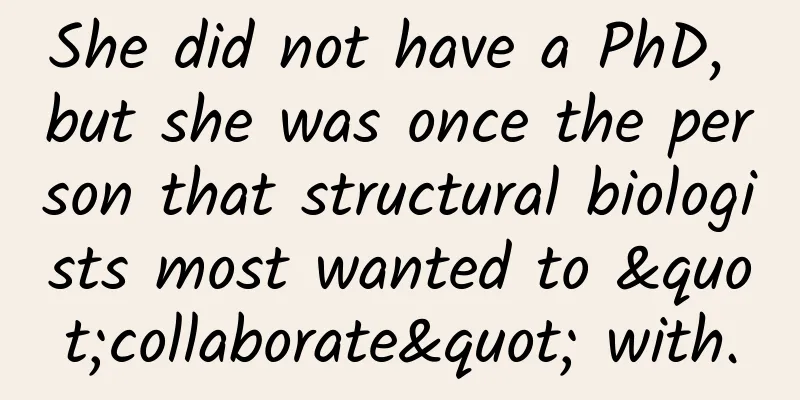She did not have a PhD, but she was once the person that structural biologists most wanted to "collaborate" with.

|
In order to simplify and visualize the complex three-dimensional structure of proteins, scientists invented the ribbon diagram composed of ribbons, lines and arrows, which is the most commonly used method of representing the three-dimensional structure of proteins today. So, how was it invented and what is its significance in the scientific community? Written by | Xiaochaxie Don't be afraid to go in new directions. Share, collaborate, and give away ideas and results freely. Don’t be afraid to try new directions. Share, collaborate, and contribute ideas and results freely. ——Jane Richardson In 1958, British biologist John Cowdery Kendrew and others successfully determined the tertiary structure of sperm whale myoglobin using X-ray diffraction and published their findings in Nature. This was the first protein in human history to have its high-level structure solved using X-ray diffraction technology. In 1962, Kendrew and Max Perutz shared the Nobel Prize in Chemistry for solving the structure of hemoglobin. Since then, structural biology has flourished as a discipline. Meanwhile, across the Atlantic Ocean in the United States, a 17-year-old girl named Jane Shelby had just won the third place in the Westinghouse Science Talent Search for calculating the trajectory of the Soviet satellite Sputnik with her naked eyes. The competition started in 1942 and continues to this day. It is now sponsored by the American company Regeneron (the competition name is Regeneron Science Talent Search), which aims to discover and cultivate scientific talents among high school students. Figure 1 Jane's grades are still available Jane's father is an electrical engineer. Perhaps influenced by her family, she developed a strong interest in mathematics and aerospace since she visited the Hayden Planetarium in New York in the third grade of elementary school. She later entered Swarthmore College, a top liberal arts college in the United States, and completed her master's degree at Harvard University. After graduation, Jane worked as a middle school teacher for a while, and then joined a laboratory at the Massachusetts Institute of Technology as a technician, where she began to get involved in the field of structural biology and met David Richardson, who was pursuing a doctorate at the time. Jane and David's relationship grew stronger during work, and they got married. After marriage, they continued to work towards the same scientific research goals. After repeatedly conducting reverse research on the examples of Kendrew and others, the two finally analyzed and demonstrated the structure of cytochrome C in 1969 - this was also the tenth protein in human history to have its structure solved. (Off topic: we say "the crystallization of love" is a metaphor, they really have crystallization. It can't be compared, it can't be compared.) As more and more protein structures are solved, structural biologists are faced with a new problem, which is how to accurately express the structure of proteins, especially to display the three-dimensional structure of proteins on a two-dimensional plane such as a paper. When Kendrew et al. published the first structure, they chose to make a model and then take a photo. Obviously, this is neither rigorous nor convenient. But people at that time did not have a better way. Around 1980, Jane was still troubled by this problem. Once, she accidentally played with a belt in her hand. The rolled belt looked like a connected amino acid skeleton, which might mean that three-dimensional proteins could be better visualized. Based on this, after a year of revision, she invented the far-reaching ribbon model (Ribbon diagram, sometimes translated as "ribbon model", etc.), and wrote a paper titled The Anatomy and Taxonomy of Protein Structure, which was published in the 1981 Advances in Protein Chemistry. The article occupies more than 170 pages, and has since established Jane Richardson's pioneering position in the field of protein "three-rendering-two (through computer or manual rendering, the three-dimensional spatial structure is rendered on two-dimensional paper, screen and other carriers for readers and viewers to read, watch and understand)". Jane's work was well received by her peers as soon as it was released. The reason is simple - it is so easy to use. The ribbon model clearly and effectively arranges and displays the amino acid skeleton that makes up the protein. Since the amino acid skeleton will spontaneously form structures such as α-helix and β-fold with lower energy, Jane creatively used a structure similar to a decorative ribbon to represent the α-helix, a flat arrow to represent the β-fold, and a thin line to represent the loop connecting the above two structures. Figure 2: The left picture shows JC Kendrew’s “model photo”; the right picture shows Jane Richardson’s “ribbon model” manuscript. Image source: Reference [1]/Jane Richardson The invention of this model amazed the entire circle, but soon colleagues found that not everyone could draw such a beautiful and accurate picture. So Jane became a popular "painter's wife" in the circle. Many colleagues wrote to her, asking: "Can you help me draw this structure of mine?" Obviously, Jane could not draw so many structures by herself, and the development of science could not rely on the artistic talent of scientists. So Jane and David thought of using computers to generate them. The 1980s and 1990s were the eras when computer technology flourished, but it took about ten years for them to finally make an algorithm that could generate ribbon models. After the computer program was completed, Jane said happily: "I finally don't have to draw by hand anymore!" It is hard to imagine what she has been through in the past ten years. Jane’s work did not end when she put down her paintbrush. She continued to delve deeper into the field of structural biology and continued to add new features to the model, many of which are still used today, such as the representation of hydrogen bonds and bound water. It is undeniable that the ribbon model has certain limitations. For example, in order to simplify the structure, it only describes the backbone of amino acids, but does not reflect the side chains. Therefore, it cannot show the channels, bumps and other binding sites on the protein surface that are important for intermolecular interactions. Therefore, later generations developed classic models such as the Ball & Stick Diagram and the Space Filling Diagram based on this model for readers to understand. Figure 3 Comparison of three commonly used models. The left one is the ribbon model invented by Jane Richardson, which focuses on the characteristics of the amino acid skeleton and domain of the protein; the middle one is the ball-and-stick model, which more accurately indicates the position of each atom; the right one is the space occupancy model, which can more intuitively present the actual spatial distribution of atoms or atomic clusters in protein molecules by displaying the volume of each atom, and shows the structural characteristics of the protein molecule surface, such as morphology, channels and pores, which is helpful in finding potential binding sites in fields such as drug development. Image source: Protein Data Bank Some people call the left picture in Figure 3 a "Cartoon" picture. In fact, different model systems have different names. For example, in the Protein Structure Database (RCSB PDB), both Cartoon and Ribbon use ribbons to represent α-helices and β-folds. The difference is that the amorphous region of Cartoon uses columnar thin lines, and arrows are used to indicate the direction of β-folds; while the amorphous region of Ribbon uses flat ribbons similar to α-helices and β-folds, and there are no arrows for β-folds - these are all changes made on Jane's original version. Figure 4 The left picture shows “Cartoon” in the PDB; the right picture shows “Ribbon” (PDB: 1FPU). There are also differences in naming in other places. For example, in the PyMol software, the “Cartoon” diagram is similar to the “Ribbon” mentioned in this article and the “Cartoon” of PDB, while the “Ribbon” is a display method that only shows the trunk, see Figure 5. Figure 5 The left picture shows “Ribbon” in PyMol, and the right picture shows “Cartoon” (PDB: 1FPU). In any case, to this day, the ribbon model is still the most successful protein model and the most common model in scientific research papers and popular science books. So many teachers have to repeatedly warn students: "This thing is just a rough idea, your body is not a bunch of arrows and spirals." I have also used this model in many of my previous works, and I would like to thank Grandma Jane. Figure 6 Jane's early drawings already have the typical features of contemporary "Ribbon" or "Cartoon". 丨Image source: doi.org/10.1038/77912 Jane Richardson and her husband David have been working for the development of structural biology and have made great contributions to protein structure analysis and structure visualization methods. They contributed to the creation of the Protein Data Bank; in 2019, they celebrated their 50th anniversary together at Duke University, and Duke University officially called Jane the Mother of Ribbon Diagrams; during the COVID-19 pandemic, they also contributed to the structural analysis of the coronavirus protein. To this day, they still have their own research group at Duke University. Figure 7 Jane Richardson | Image source: duke.edu Jane Richardson never received a formal doctorate in her life, but she received honorary doctorates from three schools. She encouraged young people to explore and said in an interview: "Sometimes I think that the way young people look at proteins now is the same as when I was in the 1980s. Maybe I invented a good way, but it is definitely not the only way. What a protein looks like depends on how you want to show it." Special Tips 1. Go to the "Featured Column" at the bottom of the menu of the "Fanpu" WeChat public account to read a series of popular science articles on different topics. 2. Fanpu provides a function to search articles by month. Follow the official account and reply with the four-digit year + month, such as "1903", to get the article index for March 2019, and so on. Copyright statement: Personal forwarding is welcome. Any form of media or organization is not allowed to reprint or excerpt without authorization. For reprint authorization, please contact the backstage of the "Fanpu" WeChat public account. |
<<: Is it harder to collect a prehistoric plant "puzzle" than to find "Dragon Balls" with a radar?
>>: Can you actually pick up cultural relics in the green belt?
Recommend
5 steps for integrated marketing promotion across the entire network, this is the normal posture
Today we are going to talk about integrated marke...
Is there a "guide to picking wild vegetables in a closed community" circulating in the circle of friends? Experts give an urgent reminder
Recently, some rumors have been circulating onlin...
You are watching Love Apartment 5 and they have already started making money. It is a small project suitable for newcomers to operate with zero cost to make money!
I have written several articles before. This is a...
How to do ASO optimization (Must read for App operation and promotion)
Share outline: 1. ASO optimization 2. How to do b...
Self-destructing and hard to detect… Flame, the most "tricky" computer worm virus in history
1. Prophecy Dadong: Xiaobai, do you remember the ...
How to operate an event well? Master these 5 steps!
If you are a new product person with 1-3 years of...
Does Apple have the courage that Google had to leave China?
In the context of economic globalization, the &qu...
Yu Jiawen did a nationwide marketing campaign without spending a penny
Yu Jiawen became famous . I have no interest in d...
Electric Technology Car News: Although it is a low-end model, it is popular. Can the low-key BMW 528Li increase sales?
The character who plays a lot of roles in the fir...
After four years, the iPhone was attacked by the most complex attack in history! One iMessage stole all private data, Karpathy exclaimed
Recently, researchers at Kaspersky discovered tha...
Summary of common commands for Android ADB development
Adb is a very commonly used command for debugging...
Yellow warning! Heavy to severe snow in parts of Liaoning and Jilin, heavy snow in some areas, please take precautions against cold and slipping
Yesterday (January 26), some areas in Liaoning an...
Case sharing: How to use red envelope fission promotion to increase APP downloads?
The gameplay of the expanding red envelope is ver...
6 ways to operate and promote Weibo, increasing followers is not a problem!
01. Understanding of Weibo Operations If you have...
Cable Network's Lost Decade
In the past 20 years, cable networks have focused...









